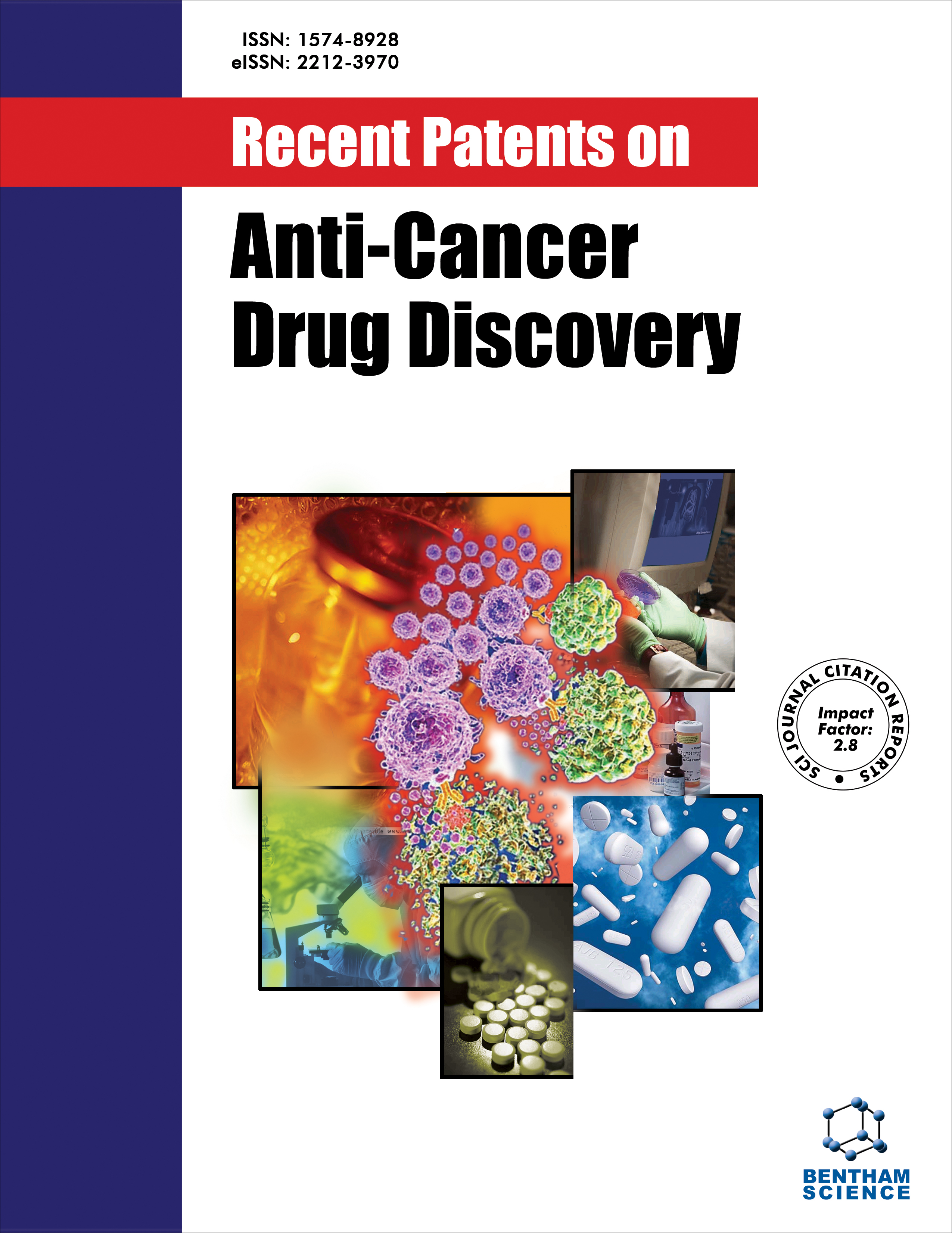- Home
- A-Z Publications
- Recent Patents on Anti-Cancer Drug Discovery
- Previous Issues
- Volume 18, Issue 3, 2023
Recent Patents on Anti-Cancer Drug Discovery - Volume 18, Issue 3, 2023
Volume 18, Issue 3, 2023
-
-
Recent Patents of Pharmaceutical Co-Crystals: Product Development on Anti-Cancer Drugs and Beyond
More LessAuthors: Abdul Azeeze M. S. Tharik and Subramania N. MeyyanathanBackground: Scientists, academicians, and researchers from academics and the pharmaceutical industries have all expressed interest in the design and production of pharmaceutical cocrystals in recent years. The development of novel drug products with enhanced physicochemical and pharmacological characteristics is aided by the cocrystallization of drug substances. Objective: The major problem with drug candidates Read More
-
-
-
Green Synthesized Nanoparticles as a Plausible Therapeutic Strategy Against Hepatocellular Carcinoma: An Update on its Preclinical and Clinical Relevance
More LessAuthors: Gopika Chandrababu, Sunil K. Sah, Ayana R. Kumar, Sabitha M and Lekshmi R. NathGreen nanotechnology can offer notable advantages over the conventional drug delivery methods in terms of improved drug stability, drug-carrying capacity, site-specificity, and feasibility to apply different routes of administration with less systemic toxicities. Metal nanoparticles bio fabricated with phytoconstituents and microbial extracts have gained significant interest for the treatment of various solid tumors includ Read More
-
-
-
Recent Patents on Plant-Derived Nanoparticles and their Potential Application Towards Various Cancer Therapeutics
More LessAuthors: S.B. Santhosh, Santny Shanmugarama, Nimma Ramesh, A. M. S. Tharik and Veera V. BasamshettyBackground: Nanotechnology plays a vital role in the field of medicine. Especially various nanoparticles such as silver, gold, platinum are involved in the treatment of different types of cancer. The effective nanoparticles were synthesized using techniques like chemical, physical, electrochemical and biological methods. In order to overcome the limitations existing in the synthesis of nanoparticles, researchers turned their attentio Read More
-
-
-
Phytochemicals and Nanoparticles in the Modulation of PI3K/Akt/mTOR Kinases and its Implications in the Development and Progression of Gastrointestinal Cancers: A Review of Preclinical and Clinical Evidence
More LessBackground: Gastrointestinal cancer are the major form of cancer in developing countries, which comprises gastric cancer (GC), hepatic cancer (HCC), colorectal cancers (CRC), etc.; they account for a large number of cancer-related deaths globally. Gastrointestinal cancers generally have a multifactorial origin, where both genetic and dietary factors play prominent roles. PI3K/Akt signaling is the prime signaling pathway asso Read More
-
-
-
Nano-Based Drug Delivery of Anticancer Chemotherapeutic Drugs Targeting Breast Cancer
More LessAuthors: Akanksha Behl and Anil K. ChhillarBackground: Chemotherapeutic drugs are principally intended to treat breast cancer. However, sooner or later, tumor drug resistance developed. These chemo drugs are effective but with numerous side effects. Breast cancer care may be extremely difficult since recurring cancer is frequently pre-treated with powerful agents. Cancer cells acquire high resistance to earlier therapies, necessitating alternative and more powerful Read More
-
-
-
Overview of Inorganic Nanoparticles: An Expanding Horizon in Tumor Therapeutics
More LessAuthors: Lalit Kumar, Shivani Verma, Puneet Utreja and Dinesh KumarBackground: Cancer is characterized by uncontrolled cell division in the human body damaging normal tissues. There are almost a hundred types of cancers studied to date that are conventionally treated with chemotherapy, radiation therapy, and surgery. Conventional methods have drawbacks like non-specific distribution of drugs, low concentration of drugs in tumors, and adverse effects like cardiotoxicity. Therefore, Read More
-
-
-
Prediction of Cancer Treatment Using Advancements in Machine Learning
More LessAuthors: Arun K. Singh, Jingjing Ling and Rishabha MalviyaMany cancer patients die due to their treatment failing because of their disease's resistance to chemotherapy and other forms of radiation therapy. Resistance may develop at any stage of therapy, even at the beginning. Several factors influence current therapy, including the type of cancer and the existence of genetic abnormalities. The response to treatment is not always predicted by the existence of a genetic mutation and mi Read More
-
-
-
Nanotechnology a Boon for Colorectal Cancer Treatment
More LessAuthors: Priyanka Kriplani and Kumar GuarveBackground: Colorectal cancer (CRC) is the third most widely spread tumor among the human population. It is usually adenocarcinomatous and develops as a polyp on the inner wall of the colon or rectum which may become malignant with time. Though its treatment is limited, its early diagnosis and prevention play a better role, thereby decreasing mortality rates. Objective: The molecular markers in CRC-affected tissue Read More
-
-
-
Gliotoxin Induced Ferroptosis by Downregulating SUV39H1 Expression in Esophageal Cancer Cells
More LessAuthors: Shengqiang Zhang, Jida Guo, Hongyan Zhang, Lu Tong and Linyou ZhangBackground: Gliotoxin, a secondary metabolite isolated from marine-derived Aspergillus fumigatus, has demonstrated anti-tumor properties in several cancers. Ferroptosis, a recently discovered type of programmed cell death that depends on the accumulation of iron and lipid peroxides, participates in the occurrence and development of various diseases, including cancer. A recent patent, US20200383943, has suggested Read More
-
-
-
Examining the Mechanisms of Huachansu Injection on Liver Cancer through Integrated Bioinformatics Analysis
More LessAuthors: Chao-yuan Huang, Yi-min Cheng, Wei Li, Yuan-cheng Huang, Hu Luo, Chong Zhong and Feng-bin LiuObjective: The objective of this study is to explore the potential anti-liver cancer mechanism of Huachansu injection through integrated bioinformatics analysis. Methods: Active ingredients of Huachansu injection (extraction of toad skin) were obtained, and their potential drug targets were predicted via SwissTargetPrediction database. Liver cancer disease targets were identified from the GEO (Gene Expression Omnibu Read More
-
Volumes & issues
-
Volume 20 (2025)
-
Volume 19 (2024)
-
Volume 18 (2023)
-
Volume 17 (2022)
-
Volume 16 (2021)
-
Volume 15 (2020)
-
Volume 14 (2019)
-
Volume 13 (2018)
-
Volume 12 (2017)
-
Volume 11 (2016)
-
Volume 10 (2015)
-
Volume 9 (2014)
-
Volume 8 (2013)
-
Volume 7 (2012)
-
Volume 6 (2011)
-
Volume 5 (2010)
-
Volume 4 (2009)
-
Volume 3 (2008)
-
Volume 2 (2007)
-
Volume 1 (2006)
Most Read This Month
Article
content/journals/pra
Journal
10
5
false
en


